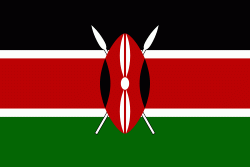Trans Nzoia District (Trans Nzoia)
Trans-Nzoia County is a county in the former Rift Valley Province, Kenya, located between the Nzoia River and Mount Elgon, 380 km northwest of Nairobi. At its centre is the town of Kitale which is the capital and largest town. The county borders Bungoma to the west, Uasin Gishu and Kakamega to the south, Elgeyo-Marakwet to the east, West Pokot to the north and the republic of Uganda to the Northwest. Trans Nzoia covers an area of 2495.5 square kilometres.
Historically the area has been inhabited by the sabaot people. After independence many of the farms vacated by white settlers were bought by individuals from other ethnic groups in Kenya. Kitale, its capital town, is now majorly luhya with inhabits from other tribes in Kenya occupying almost less than 1% of the population.
The county is largely agricultural with both large scale and small scale wheat, maize and dairy farming. The county is referred to as the basket of Kenya for its role in food production in the country. The majority of its inhabitants are however generally poor.
Historically the area has been inhabited by the sabaot people. After independence many of the farms vacated by white settlers were bought by individuals from other ethnic groups in Kenya. Kitale, its capital town, is now majorly luhya with inhabits from other tribes in Kenya occupying almost less than 1% of the population.
The county is largely agricultural with both large scale and small scale wheat, maize and dairy farming. The county is referred to as the basket of Kenya for its role in food production in the country. The majority of its inhabitants are however generally poor.
Map - Trans Nzoia District (Trans Nzoia)
Map
Country - Kenya
 |
 |
| Flag of Kenya | |
Kenya's earliest inhabitants were hunter-gatherers, like the present-day Hadza people. According to archaeological dating of associated artifacts and skeletal material, Cushitic speakers first settled in Kenya's lowlands between 3,200 and 1,300 BC, a phase known as the Lowland Savanna Pastoral Neolithic. Nilotic-speaking pastoralists (ancestral to Kenya's Nilotic speakers) began migrating from present-day South Sudan into Kenya around 500 BC. Bantu people settled at the coast and the interior between 250 BC and 500 AD. European contact began in 1500 AD with the Portuguese Empire, and effective colonisation of Kenya began in the 19th century during the European exploration of the interior. Modern-day Kenya emerged from a protectorate established by the British Empire in 1895 and the subsequent Kenya Colony, which began in 1920. Numerous disputes between the UK and the colony led to the Mau Mau revolution, which began in 1952, and the declaration of independence in 1963. After independence, Kenya remained a member of the Commonwealth of Nations. The current constitution was adopted in 2010 and replaced the 1963 independence constitution.
Currency / Language
| ISO | Currency | Symbol | Significant figures |
|---|---|---|---|
| KES | Kenyan shilling | Sh | 2 |
| ISO | Language |
|---|---|
| EN | English language |
| SW | Swahili language |















